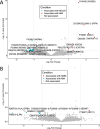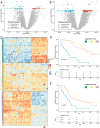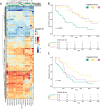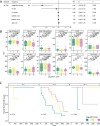Novel proteomic characterization of multiple myeloma bone marrow interstitial fluid links prognosis to coagulation pathways
- PMID: 41120896
- PMCID: PMC12542439
- DOI: 10.1186/s12014-025-09560-6
Novel proteomic characterization of multiple myeloma bone marrow interstitial fluid links prognosis to coagulation pathways
Abstract
Background: Multiple myeloma (MM), the second most prevalent hematological malignancy, carries high morbidity with variability in clinical progression among patients. This necessitates accurate risk stratification for effective therapy and life planning. While extensively genomically and transcriptomically characterized, MM remains modestly studied from a proteomic perspective. As proteomics is a closer measure of phenotype than genomic and transcriptomic assessments, addressing this gap in the literature may yield new insights into disease biology and novel biomarkers.
Methods: Herein, we applied a new sample preparation approach for mass-spectrometry based proteomics to bone marrow interstitial fluid (BMIF) from patients with MM or its precursors.
Results: We achieved deep coverage of the proteome, identifying > 11,000 protein groups (PGs) across our cohort, with an average of ~ 8900 PGs per sample. Of these, 194 PGs were significantly associated with overall survival (OS). These survival-associated PGs were enriched for those involved in coagulation, and clustering newly diagnosed MM (NDMM) based on coagulation-related proteins revealed three distinct groups characterised by globally high, medium, and low intensity of coagulation-related proteins. The group with low intensity of coagulation-related PGs had significantly reduced OS (log-rank p = 0.00078). Clustering was independent of measured clinical covariates, including chemotherapeutic regimens used, Revised International Staging System (R-ISS stage), International Normalised Ratio (INR), and age, among others.
Conclusion: Our findings support the value of fluid-based proteomic assessment of MM and suggest that coagulation-related PGs could serve as valuable novel biomarkers for risk stratification in multiple myeloma, warranting further investigation into this area.
Keywords: Coagulation Proteins; Multiple Myeloma; Prognosis; Proteomic.
© 2025. The Author(s).
Conflict of interest statement
Declarations. Ethics approval and consent to participate: This study was approved by the Nova Scotia Health Research Ethics Board in accordance with the Declaration of Helsinki and institutional guidelines, and all participants provided written informed consent (REB # 1021397, 1022793 and 1021520). Consent for publication: Not applicable. Competing interests: The authors declare no competing interests.
Figures





References
Grants and funding
LinkOut - more resources
Full Text Sources
Research Materials
Miscellaneous
